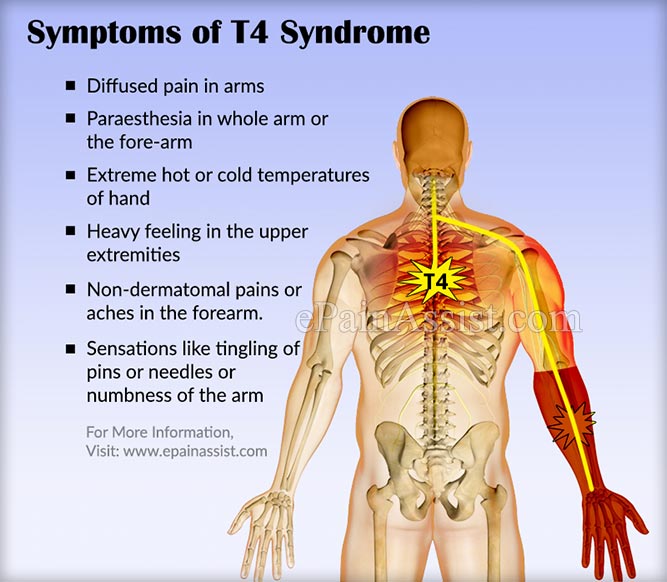What Is T4 Syndrome Or Upper Thoracic Syndrome?
T4 syndrome, also known as Upper Thoracic Syndrome refers to the pain in the upper back and is a much under-recognized or diagnosed condition. The spinal cord is divided into 5 segments: Cervical, thoracic, lumbar, sacral and coccyx. The cervical segment has 7 segments (C1-C7), the thoracic has 12 segments (T1-T12), the lumbar has 5 segments (L1-L5), the sacral also has 5 segments which are fused (S1-S5), the coccyx has only 1 segment.

T4 syndrome typically indicates pain in the 4th vertebrae of the thoracic segment of the spine. T4 syndrome is 3-4 times more common in females than in males.

Signs and Symptoms of T4 Syndrome or Upper Thoracic Syndrome
The T4 syndrome symptoms can be varied depending on the severity of the syndrome.
The Typical Symptoms of T4 Syndrome or Upper Thoracic Syndrome Include:
- Diffused pain in arms
- Paraesthesia in whole arm or the fore-arm
- Extreme hot or cold temperatures of hand
- Heavy feeling in the upper extremities
- Non-dermatomal pains or aches in the forearm or arm
- A crushing or tight band like pain
- Recurrent complain of discontinuous pain in and around the scapular region or posterior thoracic pain
- Sensations like tingling of pins or needles or numbness of the arm.

The Less Common Symptoms of T4 Syndrome or Upper Thoracic Syndrome Are:
- Occasional neck pain
- Pain radiating towards the chest
- Stiffness in the interscapular areas
- Pain might worsen at night with frequent awakes
- Stiffness in the morning
- Radiating pain towards the head and neck region
- Muscle spasms
- Both sides of the body or both arms
- A creepy-crawly feeling in the affected area.
Risk Factors of T4 Syndrome or Upper Thoracic Syndrome
The risk factors include the following:
- Poor posture
- Stiffness in the thoracic spine
- Sedentary lifestyle
- Improper techniques of lifting objects
- Poor stability of the core muscles
- Weakness or tightness of muscle in general
- Jobs involving lot of lifting, bending movement or that of using the hands extended forward from the body
- Continuous Desk or computer jobs.
What Can Cause T4 Syndrome or Upper Thoracic Syndrome?
The reason for the development of T4 syndrome depends on injury to the T4 segment of the spinal cord due to repeated bending, arching, lifting or twisting type of movement thus causing injury to the facet joints in that area. It can also be caused due to poor posture like protruding the head forward while sitting or standing, and slouching. It is common in people with cervical lordosis or cervico-thoracic kyphosis.
Women are more prone to develop the syndrome due to their structural differences from men. As the breasts develop, there is an increase in the amount of weight in the frontal part and to maintain that many would bend a little forward. The heavier the breast, the chances are more to develop T4 syndrome in women.
How is T4 syndrome or Upper Thoracic Syndrome Diagnosed?
Due to the absence of a clear-cut way to diagnose T4 syndrome, physicians would generally have a close look on the symptoms and some physical tests to determine the presence of the condition. Increase in the intensity of pain while palpating the area is an important diagnosis. MRI and CT scan could be done in some cases for a deeper analysis of the condition. Doctors would ideally rule out other conditions like Thoracic Outlet Syndrome (TOS), Carpal Tunnel Syndrome, Neurological disease, Ankylosing Spondylitis, Vertebral fracture, Intercostal Neuralgia, and other closely related condition for a definite diagnosis.
Treatment for T4 Syndrome or Upper Thoracic Syndrome
The treatment of T4 Syndrome solely depends on physiotherapy. An experienced physiotherapist will provide manual therapy with an impairment based approach. The sessions would start with manual therapy and slowly would progress to home exercise. The sessions would include some or combinations of the following techniques:
- Joint manipulation and mobilization of the thoracic and cervical spine
- Soft tissue massage
- Taping or bracing
- Electrotherapy viz., ultrasound or laser
- Dry needling
- Training in Pilates
- Ergonomic advice
- Postural correction
- Water or hydrotherapy
- Stretching and strengthening exercises of the upper back
- Exercises for flexibility and stabilization of the core muscles.
If the physiotherapy is not providing relief from the T4 Syndrome pain, the healthcare professional might consider invasive techniques like Corticosteroid or NSAIDs injection into the T4 joint. This may relieve some of the pain symptoms but physiotherapy is a must for this disorder.
Self-Help and Recovery Period for T4 Syndrome or Upper Thoracic Syndrome
Along with the pain medications, if prescribed, and the physiotherapy, one can maintain the following things during the treatment to get a faster recovery.
- Sitting for longer period: Sitting for a longer period of time at a stretch is a big no-no for patients with T4 syndrome. Sitting in a slouching position is even worse. To prevent worsening of the pain and the disorder, it is advised to take breaks every 10-15 minutes and sitting is allowed for a maximum period of 2 hours with the breaks. In addition to it, sit in a chair with a good and complete back support and place a pillow or a rolled towel in between your lower back and the chair to reduce the strain in the upper back.
- Rest: It is essential for people with T4 syndrome to take proper rest as too much of physical activity especially involving those of the upper back could produce further injury and aggravate the condition or prolong the recovery phase.
- Compressions: Cold compressions followed by hot compressions can relieve the T4 Syndrome pain to some extent. This if coupled with muscle relaxant ointments would relieve the pain for a little longer period of time.
- Exercise: It is very essential to follow the regular exercise regime suggested by the physiotherapist.
With regular physiotherapy and exercise coupled with the self-help techniques a better and faster recovery is expected. Ideally it takes around 2-3 weeks to return back to the regular work schedules for the patient without any other symptom. T4 syndrome could be managed and treated very effectively provided the suggestions by the doctors and physiotherapists are followed wholeheartedly.
